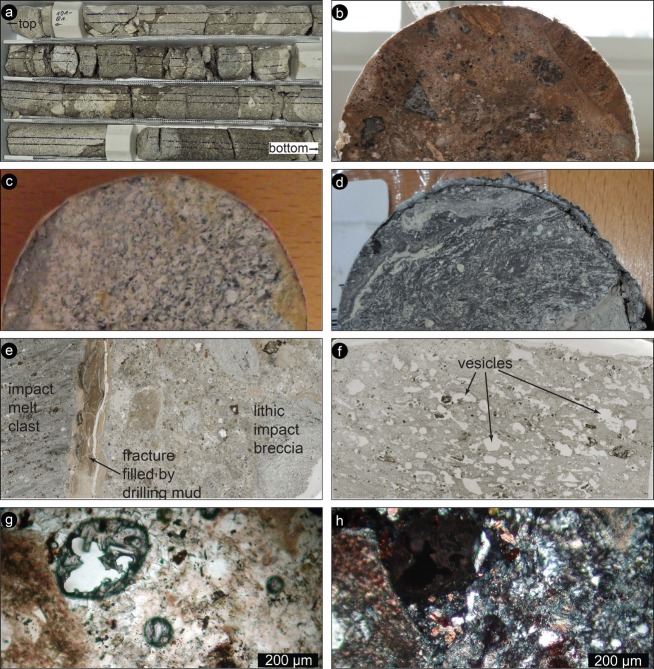Fig. 12.
Interval 320–328 mblb. a) Box containing core run 101 (approximately 319–321 mblb). The core width is 6 cm. The lacustrine sediment contribution is reduced in comparison with the core above, but the likely impact melt bodies dominate in this section. Whitish and blackish porous melt boulders, tens of cm long, are visible in the lower rows of the box. b) Sample of impact breccia, with poorly sorted clasts of volcanic rocks and impact melt clasts in a reddish matrix. Sample 6 cm wide. Sample 99Q5-W34-38 (321.3 mblb). c) Sample of likely volcanic rock, grayish in color, showing a layering and few whitish grains. Sample 6 cm wide. Sample 99Q5-W15-17 (321 mblb). d) Sample of impact melt clast, blackish in color and showing a definite internal flow fabric. At the right lower corner of the sample, the contact with the breccia is visible; breccia contains some lacustrine sediments. Sample 6 cm wide. Sample 101Q3-W41-43 (325.8 mblb). e) Contact between a fragment of impact melt (on the left) and the impact breccia (on the right). The contact is marked by a layer of clay, probably from the drilling mud, injected in the open fractures. Picture 3 cm wide. Thin section scan. Sample 101Q6-W11-13 (326.6 mblb). f) Impact melt. Note the extensive vesiculation. The darker portions may represent unmelted material. Picture 3 cm wide. Thin section scan. Sample 101Q8-W41-43 (327.6 mblb). g) The impact breccia matrix. Portion of the impact breccia with a glassy appearance and with rounded vesicles filled by secondary minerals. Sample 99Q3W17-19 (319.1 mblb). Plane-polarized light microphotograph. h) The same area but under cross-polarized light. The glassy matrix is pervasively devitrified. Sample 99Q3-W17-19 (319.1 mblb). Cross-polarized light microphotograph.

